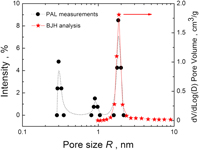Crossref Citations
This article has been cited by the following publications. This list is generated based on data provided by
Crossref.
Golovchak, R.
Thapar, P.
Ingram, A.
Savytskii, D.
and
Jain, H.
2014.
Influence of phase separation on the devitrification of 45S5 bioglass.
Acta Biomaterialia,
Vol. 10,
Issue. 11,
p.
4878.
Klym, Halyna
Ingram, Adam
Shpotyuk, Oleh
Hadzaman, Ivan
and
Solntsev, Viacheslav
2016.
Water-Vapor Sorption Processes in Nanoporous MgO-Al2O3 Ceramics: the PAL Spectroscopy Study.
Nanoscale Research Letters,
Vol. 11,
Issue. 1,
Klym, H.
Ingram, A.
Shpotyuk, O.
Hadzaman, I.
Solntsev, V.
Hotra, O.
and
Popov, A. I.
2016.
Positron annihilation characterization of free volume in micro- and macro-modified Cu0.4Co0.4Ni0.4Mn1.8O4 ceramics.
Low Temperature Physics,
Vol. 42,
Issue. 7,
p.
601.
Klym, H.
Ingram, A.
Shpotyuk, O.
Hadzaman, I.
Hotra, O.
and
Kostiv, Yu.
2016.
Nanostructural Free-Volume Effects in Humidity-Sensitive MgO-Al2O3 Ceramics for Sensor Applications.
Journal of Materials Engineering and Performance,
Vol. 25,
Issue. 3,
p.
866.
Shpotyuk, O.
Ingram, A.
and
Shpotyuk, Ya.
2018.
Free-volume characterization of nanostructurized substances by positron annihilation lifetime spectroscopy.
Nuclear Instruments and Methods in Physics Research Section B: Beam Interactions with Materials and Atoms,
Vol. 416,
Issue. ,
p.
102.
Klym, H.
Ingram, A.
Shpotyuk, O.
Hadzaman, I.
and
Chalyy, D.
2018.
Water-Sorption Effects near Grain Boundaries in Modified MgO-Al2O3 Ceramics Tested with Positron-Positronium Trapping Algorithm.
Acta Physica Polonica A,
Vol. 133,
Issue. 4,
p.
864.
Ingram, A.
2019.
Atomic-deficient nanostructurization in water-sorption alumomagnesium spinel ceramics MgAl2O4.
Applied Nanoscience,
Vol. 9,
Issue. 5,
p.
731.
Klym, H
Ingram, A
Hadzaman, I
Karbovnyk, I
Vasylchyshyn, I
and
Popov, A I
2019.
Nanoporous characterization of modified humidity-sensitive MgO-Al2O3 ceramics by positron annihilation lifetime spectroscopy method.
IOP Conference Series: Materials Science and Engineering,
Vol. 503,
Issue. ,
p.
012019.
Klym, H.
2021.
Nanomaterials and Nanocomposites, Nanostructure Surfaces, and Their Applications.
Vol. 263,
Issue. ,
p.
349.



